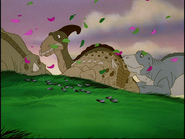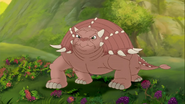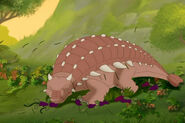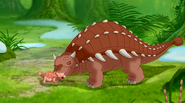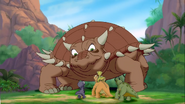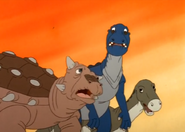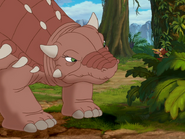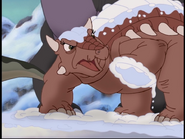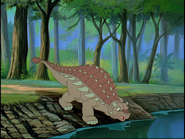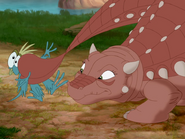Ankylosaurus was a late Cretaceous ankylosaur that lived about 68 to 66 million years ago in North America. It was the size of an elephant. It lived alongside carnivores such as Tyrannosaurus rex but like all ankylosaurs was not in any danger from them due to its armored back - which no carnivore would be able to bite through - and tail club, which could mortally injure a T. rex.
Description[]

Size of the smallest (AMNH 5214) and largest (CMN 8880) known specimens, compared to a human
Compared with modern land animals the adult Ankylosaurus was very large. Some scientists have estimated a length of 9 meters (30 ft).[1] Another reconstruction suggests a much smaller size, at 6.25 m (20.5 ft) long, up to 1.5 m (5 ft) wide and about 1.7 m (5.5 ft) high at the hip.[2] Ankylosaurus may have weighed over 6,000 kilograms (13,000 lb),[3] making it one of the heaviest armored dinosaurs yet discovered. The body shape was low-slung and quite wide. It was quadrupedal, with the hind limbs longer than the forelimbs. Although its feet are still unknown, comparisons with other ankylosaurids suggest Ankylosaurus probably had five toes on each foot. The skull was low and triangular in shape, wider than it was long. The largest known skull measures 64.5 centimeters (25 in) long and 74.5 cm (29 in) wide.[4] Their teeth were weaker than ceratopsid and hadrosaurid dinosaurs of the time, so they probably chewed very little.
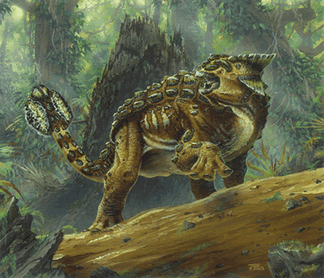
Armor[]

Arrangement of armor as suggested by Arbour and Mallon, 2017
The armor of Ankylosaurus was made of huge knobs and plates of bone, known as osteoderms or scutes, embedded in the skin. Osteoderms are also found in the skin of crocodiles, armadillos and some lizards. The bone may have been covered by a tough, horny layer of keratin. These osteoderms ranged in size, from wide, flat plates to small, round nodules. The plates were lined up in regular horizontal rows down the animal's neck, back, and hips, with the many smaller nodules protecting the areas between the large plates. Smaller plates may have been on the limbs and tail. Compared to the slightly more ancient ankylosaurid Euoplocephalus, the plates of Ankylosaurus were smooth in texture, without the high keels found on the armor of the nodosaurid Edmontonia. A row of flat, triangular spikes may have stuck out sideways along each side of the tail. Tough, rounded scales protected the top of the skull, while four horns were behind the eyes and the ends of the mouth.[5]
Tail club[]
Classification Ankylosaurus was named as the type genus of the family Ankylosauridae.[6] Ankylosaurids are members of the larger taxon Ankylosauria, which also contains the nodosaurids. Ankylosaur phylogeny is a heated topic, with several mutually exclusive studies given in recent years, so the exact position of Ankylosaurus within Ankylosauridae is unknown. Ankylosaurus and Euoplocephalus are often thought to be sister taxa.[1] However, other studies have found these genera in different positions.[7][8] Further discoveries or research may clear up the situation.
History[]

Skull of holotype AMNH 5895 and reconstruction diagram of same
Ankylosaurus was named by American paleontologist Barnum Brown, in 1908. The name comes from the Greek words αγκυλος/ankulos ('curved') and σαυρος/sauros ('lizard'). Brown intended this name in the same sense as the medical term ankylosis, to refer to the stiffness from the fusion of many bones in the skull and body, so the name is often translated as 'stiffened lizard.' The type species is A. magniventris, from the Latin magnus ('great') and venter ('belly'), referring to the great width of the animal's body.[6]

1908 skeletal reconstruction of the holotype, with missing parts restored after Stegosaurus
Paleobiology[]
Ankylosaurus magniventris lived between 66.5 to 65.5 million years ago, in the final Maastrichtian stage of the Late Cretaceous Period, and was one of the last dinosaur species that appeared before the Cretaceous-Tertiary extinction event. The type specimen is from the Hell Creek Formation of Montana, while other specimens have been found in the Lance Formation of Wyoming and the Scollard Formation in Alberta, Canada, all of which date to the end of the Cretaceous.[1]
The Lance, Hell Creek and Scollard Formations represent different sections of the western shore of the shallow that divided western and eastern North America during the Cretaceous. They represent a broad coastal plain, extending westward from the seaway to the newly formed Rocky Mountains. These formations are composed largely of sandstone and mudstone, which have been attributed to floodplain environments.[9][10][11] The Hell Creek is the best studied of these ancient environments. At the time, this region was subtropical, with a warm and humid climate. Many plant species were supported, primarily angiosperms, with less common conifers, ferns and cycads. An abundance of fossil leaves found at dozens of different sites indicates that the area was largely forested by small trees.[12] Ankylosaurus shared its environment with dinosaurs including the ceratopsids Triceratops and Torosaurus, hypsilophodont Thescelosaurus, hadrosaurid Edmontosaurus, nodosaurid Denversaurus, pachycephalosaurian Pachycephalosaurus, and the theropods Ornithomimus and Tyrannosaurus.[13][14]
Fossils of Ankylosaurus are quite rare in these grounds, compared to Edmontosaurus and the superabundant Triceratops, which make up most of the large herbivore fauna. Another ankylosaur, Denversaurus, is also found in the same formations. However, Ankylosaurus and Denversaurus seem to have been separated both geographically and ecologically. Ankylosaurus had a wide muzzle, perhaps used for non-selective grazing and thus may have been limited to the upland regions, away from the coast, while Denversaurus had a narrower muzzle, indicating a more selective diet, and seems to have lived at lower elevations, closer to the coast.[2]
Ankylosaurus in The Land Before Time[]
They are known as Clubtails to the Land Before Time dinosaurs. They first appeared in The Land Before Time II: The Great Valley Adventure, in The Land Before Time III: The Time of the Great Giving, the most notable Ankylosaurus in the series, Mr. Clubtail, is introduced. In the franchise, Ankylosaurs have armor on their noses, two horn-like spikes on the tops of their heads, two small spikes at the sides of their jaws, square-shaped armor-plates on their backs, spikes along their sides, pebble-like bumps in the corner of each armor-square, short legs and tails, and two-lobed tail-clubs. They also bear a very loose resemblance to Anguirus, a monster from the Godzilla franchise, who is himself based upon Ankylosaurus.
Aside from Mr. Clubtail, a number of other Ankylosaurus appear in the series, particularly Kosh from the TV series episode, "The Star Day Celebration", and an unnamed clubtail from "The Amazing Threehorn Girl".
Gallery[]
References[]
- ↑ 1.0 1.1 1.2 Vickaryous, M.K., Maryanska, T., & Weishampel, D.B. 2004. Ankylosauria. In: Weishampel, D.B., Dodson, P., & Osmólska, H. (Eds.). The Dinosauria (2nd edition). Berkeley: University of California Press. Pp. 363-392.
- ↑ 2.0 2.1 2.2 Carpenter, K. 2004. Redescription of Ankylosaurus magniventris Brown 1908 (Ankylosauridae) from the Upper Cretaceous of the Western Interior of North America. Canadian Journal of Earth Sciences 41: 961–986.
- ↑ Coombs, Walter P. (December 1978). "Theoretical Aspects of Cursorial Adaptations in Dinosaurs". The Quarterly Review of Biology 53 (4): 393–418. doi:10.1086/410790.
- ↑ Carpenter, K. 2004. Redescription of Ankylosaurus magniventris Brown 1908 (Ankylosauridae) from the Upper Cretaceous of the Western Interior of North America. Canadian Journal of Earth Sciences 41: 961–986
- ↑ Carpenter K. 2004. Redescription of Ankylosaurus magniventris Brown 1908 (Ankylosauridae) from the Upper Cretaceous of the Western Interior of North America. Canadian Journal of Earth Sciences, 41: 961–986.
- ↑ 6.0 6.1 Brown, B. 1908. The Ankylosauridae, a new family of armored dinosaurs from the Upper Cretaceous. Bulletin of the American Museum of Natural History 24: 187–201.
- ↑ Carpenter, K. 2001. Phylogenetic analysis of the Ankylosauria. In: Carpenter, K. (Ed.). The Armored Dinosaurs. Bloomington: Indiana University Press. Pp. 454–483.
- ↑ Hill, R.V., Witmer, L.M., & Norell, M.A. 2003. A new specimen of Pinacosaurus grangeri (Dinosauria: Ornithischia) from the Late Cretaceous of Mongolia: ontogeny and phylogeny of ankylosaurs. American Museum Novitates 3395: 1-29.
- ↑ Lofgren, D.F. 1997. Hell Creek Formation. In: Currie, P.J. & Padian, K. (Eds.). The Encyclopedia of Dinosaurs. San Diego: Academic Press. Pp. 302-303.
- ↑ Breithaupt, B.H. 1997. Lance Formation. In: Currie, P.J. & Padian, K. (Eds.). The Encyclopedia of Dinosaurs. San Diego: Academic Press. Pp. 394-395.
- ↑ Eberth, D.A. 1997. Edmonton Group. In: Currie, P.J. & Padian, K. (Eds.). The Encyclopedia of Dinosaurs. San Diego: Academic Press. Pp. 199-204.
- ↑ Johnson, K.R. 1997. Hell Creek Flora. In: Currie, P.J. & Padian, K. (Eds.). The Encyclopedia of Dinosaurs. San Diego: Academic Press. Pp. 300-302.
- ↑ Weishampel, David B.; Barrett, Paul M.; Coria, Rodolfo A.; Le Loeuff, Jean; Xu Xing; Zhao Xijin; Sahni, Ashok; Gomani, Elizabeth, M.P.; and Noto, Christopher R. (2004). "Dinosaur Distribution". The Dinosauria (2nd). 517–606.
- ↑ Phillip Bigelow. "Cretaceous "Hell Creek Faunal Facies"; Late Maastrichtian". http://www.scn.org/~bh162/hellcreek2.html. Retrieved on 2007-01-26.

